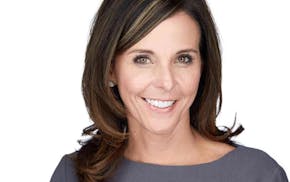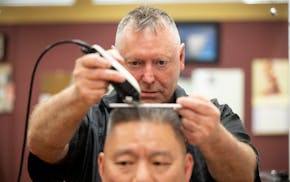Small business is back. Anecdotal evidence and some hard data indicate that the five-year economic recovery is being boosted, finally, by small firms that employ several to several hundred employees.
"This has been an abnormal economic expansion because of the absence of small business," said Scott Anderson, chief economist at the Bank of the West. "For the first time we are really starting to see small business pull at least its own weight in terms of investment and expanding. There had been so much economic fear and uncertainty, including the health care changes, the government shutdown and tight credit for small business. That's less of a factor in the last year."
Consumers, a particularly important source of income for small business, were busy paying down debt when the economic expansion started, he said. That limited the growth in consumer spending to about 1.5 percent annually. Now, Anderson is forecasting growth of 2.8 percent in the current quarter and 3 percent next year.
"Consumers are healthier," he said. "And they're giving small business some confidence."
In 2010, Jeff Warner, president of family-owned Warners' Stellian appliances, was trying to eke out a 2 percent sales gain in the wake of a punishing recession that had cut the retailer's revenue by 10 percent.
This year, Warner is looking forward to a second consecutive year of double-digit sales growth. He has added an eighth retail location. And Warners' Stellian employment has grown from 200 workers three years ago to 250 today as its sales and service business benefits from rising home prices, remodeling projects and consumer confidence.
"I'd call it controlled growth," said Warner, 58, who joined the family business as a teenager. "We're also looking at a couple of prospective store sites in the Twin Cities metro area."
At Hage Concrete Works of Edina, a contractor specializing in driveways, patios and retaining walls, business manager Franny Hage said the 20-employee firm is completing its best sales year since the "roaring 1990s."
Julie Kearns, owner of Junket: Tossed & Found, once sold an eclectic mix of art supplies, used clothing, furniture, sewing notions, hardware and kitchen tools only online and from her home. Last year she moved into a 3,000-square-foot shop on Minnehaha Avenue S. in Minneapolis. She recently expanded store hours.
"Business is great," Kearns said last week. "We're optimistic."
Consumers are back
The early years of the recovery were marked by America's largest companies regaining record profitability through productivity increases and modest investments in technology without adding workers or increasing wages following layoffs in 2007-09. Wall Street, aided by Federal Reserve policies that kept interest rates low, drove investors into the fast-advancing equity market, but that didn't do much for Main Street or employment for three years.
Small businesses, faced with fewer customers in a jobless recovery who made smaller purchases, were not about to hire or expand.
"It was easier for big firms to get credit earlier or go to the capital markets or other options that aren't available to smaller companies," said Dan Heckman, national investment consultant at the Private Client Reserve of U.S. Bancorp. "And it was tougher for them to get bank loans for regulatory reasons. There was a lag. As the economic backdrop has gotten better, and employment has improved, and commodity prices such oil and gasoline have dropped in price, that gives more confidence to consumers.
"We think all the stars are aligning now for small business."
In November, the National Federation of Independent Business Optimism index rose to a healthy 96.1. Heckman said other recent surveys show that "U.S. business confidence, small and large, is the highest since 2006."
Small businesses, which employ more than half the labor force, constitute up to 99 percent of all businesses. For every Exxon Mobil or Target, there are thousands of small auto-repair shops, contractors and independent retailers.
The recent news also should be good for the working class and working poor, the $20-an-hour-and-under crowd whose wage stagnation for years was compounded by layoffs and wage cuts. Meanwhile, the incomes and wealth of the nation's most affluent earners soared, thanks partly to a robust stock market.
Signs of wage growth
Bloomberg reported late last month, based on a Goldman Sachs report, that incomes of those making less than $12.50 an hour climbed nearly 4 percent over the last year compared with 2.5 percent for those making $45 an hour. The pickup for the lower-paid workers was attributed mostly to an increase in hours.
Still, as states such as Minnesota raise their minimum wage gradually from $6.50 an hour to $9.50 by 2016, and as demand for workers rises in a growing economy with baby boomers retiring, wages should start increasing.
The average weekly wage in Minnesota, where unemployment has dropped markedly to under 4 percent this year, rose from $1,001 in the first quarter of 2013 to $1,036 in the first quarter of 2014, a 3.5 percent hike. That doesn't speak just to lower-end workers.
"Minnesota employment was 3.9 percent in October, the best level since 2006," Anderson, the economist, said. "That is basically full employment. I would expect to see some upward pressure on wages."
Jeff Warner said Warners' Stellian is paying workers $12 to $20 per hour," plus benefits, a 401(k) retirement plan and profit-sharing.
"We don't operate like a big public company," said Warner, who competes against Best Buy and other big retailers. "I think there's more sharing. We have to pay to get and retain the right people."
Neal St. Anthony • 612-673-7144 • neal.st.anthony@startribune.com

St. Anthony: 'Patient' investing paying off for St. Paul's Hill Capital

Jennifer Smith, leader of Burnsville's Innovative Office Solutions, has died

St. Anthony: Medical professions in Minnesota need more people of color in their ranks



